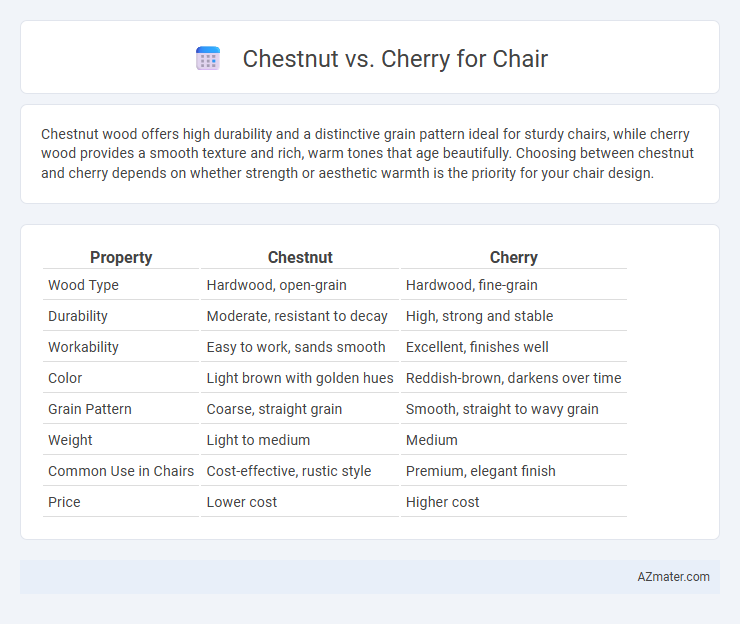Chestnut wood offers high durability and a distinctive grain pattern ideal for sturdy chairs, while cherry wood provides a smooth texture and rich, warm tones that age beautifully. Choosing between chestnut and cherry depends on whether strength or aesthetic warmth is the priority for your chair design.
Table of Comparison
| Property | Chestnut | Cherry |
|---|---|---|
| Wood Type | Hardwood, open-grain | Hardwood, fine-grain |
| Durability | Moderate, resistant to decay | High, strong and stable |
| Workability | Easy to work, sands smooth | Excellent, finishes well |
| Color | Light brown with golden hues | Reddish-brown, darkens over time |
| Grain Pattern | Coarse, straight grain | Smooth, straight to wavy grain |
| Weight | Light to medium | Medium |
| Common Use in Chairs | Cost-effective, rustic style | Premium, elegant finish |
| Price | Lower cost | Higher cost |
Introduction to Chestnut and Cherry Woods
Chestnut wood, prized for its durability and rich, warm tones, offers a rustic appeal with straight grain and coarse texture, making it ideal for sturdy chair construction. Cherry wood features a smooth, fine grain and a reddish-brown hue that deepens with age, providing an elegant and refined finish often sought in high-end furniture. Both woods balance strength and aesthetic appeal, but chestnut leans toward robust, rustic styles, while cherry emphasizes sophistication and smoothness in chair-making.
Overview of Chestnut Wood Characteristics
Chestnut wood features a lightweight yet durable structure with a coarse, straight grain that enhances its rustic appeal and workability in chair making. It offers natural resistance to decay and insect damage, making it suitable for both indoor and outdoor furniture applications. The warm, golden to reddish-brown hues of chestnut provide an attractive finish that ages gracefully over time.
Overview of Cherry Wood Characteristics
Cherry wood is prized for its rich, warm reddish-brown hue that deepens with age, making it a popular choice for elegant chair craftsmanship. Its fine, smooth grain ensures a sleek finish and exceptional durability, ideal for furniture that withstands regular use. Cherry wood's natural resistance to warping and its ability to take stain well contribute to long-lasting, aesthetically pleasing chairs.
Durability: Chestnut vs Cherry for Chairs
Chestnut offers moderate durability with a Janka hardness rating around 690, making it resistant to wear but prone to dents over time, while cherry wood ranks higher at approximately 950, providing better resistance to scratches and impacts. Both woods develop a rich patina with age, but cherry's tighter grain contributes to enhanced strength and longevity in chair construction. For chairs subjected to heavy use, cherry is generally preferred due to its superior hardness and ability to maintain structural integrity.
Appearance and Color Differences
Chestnut wood features a pale to medium brown color with subtle golden hues and straight grain patterns that offer a rustic, warm appearance ideal for traditional chairs. Cherry wood presents a richer, reddish-brown tone that darkens with age and exposure to light, creating a smooth, elegant finish favored in fine furniture making. The contrast in grain texture and color depth between chestnut's coarse consistency and cherry's finer, more uniform grain significantly impacts the visual appeal and style of chair designs.
Workability and Ease of Crafting
Chestnut wood offers superior ease of crafting due to its moderate hardness and straight grain, making it highly workable for chair construction and allowing for smooth shaping and sanding. Cherry wood, while denser and slightly harder than chestnut, provides excellent workability with a fine, even texture that responds well to machining and hand tools, enhancing detail work and finishing. Both woods finish beautifully, but chestnut's softer nature reduces tool wear, whereas cherry's stability and resistance to warping ensure long-lasting structural integrity in chair making.
Cost Comparison: Chestnut vs Cherry
Chestnut chairs typically cost less than cherry chairs due to chestnut's greater availability and faster growth rate, which lowers material expenses. Cherry wood carries a higher price, reflecting its superior durability, rich color, and fine grain that enhance furniture quality and aesthetic appeal. Choosing chestnut offers budget-friendly options, while cherry justifies its premium cost with long-lasting elegance and increased resale value.
Maintenance and Longevity
Chestnut wood requires less maintenance due to its natural resistance to decay and insects, making it ideal for long-term use in chair construction. Cherry wood, while aesthetically pleasing with its rich aging patina, needs regular conditioning and protection from sunlight to prevent fading and surface damage. Chairs crafted from chestnut typically offer greater longevity with minimal upkeep, whereas cherry demands more attentive care to maintain its appearance and structural integrity.
Sustainability and Environmental Impact
Chestnut wood is often considered more sustainable than cherry due to its faster growth rate and wider availability, which reduces deforestation pressure. Cherry wood, while prized for its rich color and durability, grows more slowly and is typically harvested from older trees, potentially increasing environmental impact. Choosing chestnut for chair manufacturing supports responsible forestry practices and helps minimize ecological footprints linked to wood sourcing.
Best Choice: Chestnut or Cherry for Your Chair
Chestnut wood offers exceptional durability and a warm, rustic appearance, making it ideal for chairs that prioritize strength and long-lasting use. Cherry wood features a smooth grain and rich reddish hue that deepens with age, perfect for elegant and refined chair designs. Choosing between chestnut and cherry depends on whether you prefer a robust, traditional look or a polished, sophisticated finish for your chair.

Infographic: Chestnut vs Cherry for Chair
 azmater.com
azmater.com